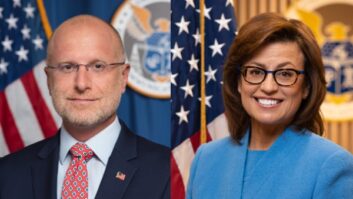At Thursday’s FCC meeting, Acting Chairwoman Jessica Rosenworcel used the occasion of her trip to Louisiana to explain several commission initiatives.
In a written statement, she described the damage done by Hurricane Ida and summarized steps the FCC had taken before and after that storm.
“But we have to understand where communications fell short, where recovery took too long, and what changes can be made to make our networks more resilient before the next unthinkable event occurs,” she wrote in comments released by her office.
She talked about the NPRM that the FCC has adopted to strengthen its DIRS system and possibly to require backup power at communications facilities including broadcast stations.
The text of her statement is below:
This week I had the opportunity to see firsthand the devastation wrought by Hurricane Ida. Commissioner Carr joined me to crisscross a long, flat stretch of Louisiana — from Baton Rouge to New Orleans. The drive itself was telling. Along the way we saw cruel reminders of the storm and the great damage wind and water can do — mangled store signs and piles of refuse still being cleared away. Still, what struck me most was all the blue. Not the grey-blue of Lake Pontchartrain. Instead, it was the bright blue of heavy plastic tarps. They were everywhere. On the pitched rooves of homes. On the flat tops of commercial buildings. They were part of fixing what had blown away.
That image stays with me. But so does the strength and resilience of everyone we met. They love where they live and are deeply committed to restoration in their communities. They are also deeply invested in making sure that when the next storm comes — and it will — they are better prepared. Being better prepared means having more resilient communications. It means making sure our networks work when we need them most. I spoke with Governor John Bel Edwards about this before our trip and I heard it from everyone we met — state public safety leaders in Baton Rouge, 911 call center operators in Livingston, broadband companies in LaPlace, and FirstNet officials in Raceland.
Everyone we spoke with wanted to tell us their stories and give us their ideas. They wanted us to know what worked and what didn’t and how stronger and more resilient communications can save lives. I’m grateful Commissioner Carr was able to join me and thank all my colleagues for supporting the swift actions the agency took to assist before and after the storm.
In anticipation of landfall, the Federal Communications Commission set up an information hub for Hurricane Ida, with emergency communications tips in nine languages, tailored media advisories for broadcasters, downloadable Public Service Announcements, communications status reports, and other content.
We deployed FCC staff to Louisiana and the Federal Emergency Management Agency Regional Response Coordination Center in Dallas, Texas, to support spectrum management, perform damage assessments, and prioritize recovery efforts.
In coordination with FEMA and other federal partners, we activated our Disaster Information Reporting System. As a result, we published the first comprehensive assessment of Hurricane Ida’s impact on communications networks followed by daily updates.
We provided technical assistance to 911 coordinators, State Emergency Operations Centers, 911 call centers, carriers implementing the Wireless Resiliency Cooperative Framework and other communications providers, and the Louisiana Association of Broadcasters.
We engaged in daily coordination with Federal, state, and local partners, as well as with industry, to help coordinate the transport of necessary communications equipment, fuel, and other resources to help fill communications gaps. We also set up a first-of-its kind team to address coordination with utilities to prevent accidental fiber cuts during debris removal and restoration.
Of course, we had help. Communications companies worked long and hard to restore critical services. All of this made a difference. More than 98 percent of the cell sites in the affected counties have been restored. Other outages trended downward as fast as power was restored.
This is progress. But we have to understand where communications fell short, where recovery took too long, and what changes can be made to make our networks more resilient before the next unthinkable event occurs.
Today’s rulemaking gets that effort going. We start by taking a second look at the voluntary Wireless Resiliency Cooperative Framework and its disaster roaming and asking where can it be strengthened. Are best practices enough? Should coordination happen earlier? Be more automatic? This was something that came up repeatedly in our discussions in Louisiana — a desire for this cooperative roaming to work faster, work better, and help keep more people connected in disaster.
We also revisit our Disaster Information Reporting System and seek targeted comment on where there are gaps that need to be filled. 911 call centers should not be the last ones to find out where there are critical network failures. But we learned that during Hurricane Ida, that is exactly what happened. So we ask about how we can improve data collection and timely notification during disasters.
Finally, we renew our inquiry into backup power for communications facilities. Our review of the data collected in the aftermath of Hurricane Ida reveals that the lack of commercial power at key equipment and facilities is the single biggest reason why communications networks failed. Left unaddressed, this problem will only get worse in coming years as we experience disasters with increasing severity, duration, and impact. So our rulemaking explores resilience strategies for power outages — including better coordination between communications providers and power companies and backup power or other measures that could help keep service running after a disaster.
I am hopeful that this rulemaking is the beginning of a broader discussion of our need for resilient networks. Look around. We have hurricanes in Louisiana, a snowstorm in Texas, and wildfires out West. These issues are not going away. We need to think deeply about what network resiliency means and how our policies can support it. So in addition to this rulemaking, next month the FCC will hold a virtual field hearing on Hurricane Ida and the resilient networks now needed in disaster more generally. To make it simple, we’ll have it as part of our monthly open meeting in October. Stay tuned for details.







